
|
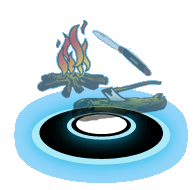
|
Fire, Knife, and Axe - Knife Portal
|

|





|
Whether you have a multi-tool or a simple pocket knife, a knife is in a scout's list of ten essentials for a very good reason.
Aside from water, I believe that the pocket knife is the second most important item on the list.
A multi-tool is extremely versatile and can be used from cooking your meals to breaking down wood for fire or even repairing backpacking stoves.
Knives comes in many different designs and are made from different material; however the general consensus for Boy Scouts using knives is that the knives should not be longer than the palm of your hand and that unsheathed knives should be avoided.
Ultimately the decision rests upon the Scoutmaster and the scout's parents.
So I would ask their recommendation before selecting a knife.
|
Materials
Like other camping gear, knifes are made with different materials, each with their pros and cons.
The most common type of materials are stainless steel, titanium, and high carbon steel.
Ceramic is also another material used for knives.
Ceramic knives are extremely hard and do not retain flavors, if used as utensils, however ceramic is similar to cast iron where the knife will crack when dropped; this reduces the usability of ceramic as a multi-tool or pocket knife.
Instead, ceramic knives are normally used in the kitchen.
Stainless Steel
Stainless steel is one of the most popular materials used in pocket knives.
It is extremely durable and does not corrode easily.
Its price is also low compared to other materials which is another reason why it is popular.
While this material is cheap and resistant to rust, they are not immune to corrosion.
Certain materials can still corrode the material.
In addition, stainless steel are unable to keep a extremely sharp blade, like that of a high carbon steel knife.
|
 
|
Titanium
Titanium knives are normally used in areas where weight is an important factor.
Titanium is lighter than stainless steel and, like stainless steel, are resistant to rust and corrosion.
The main drawback with titanium knives is that the titanium material is softer than other materials which means the blade must be sharpen more often.
|
 
|
High Carbon Steel
While not as popular as stainless steel, many pocket knives are made with high carbon steel.
Given the high concentration of carbon in the steel, high carbon steel is extremely hard and can be sharpen to have one of sharpest blades compared to the other materials.
However, unlike the other materials, high carbon steel is susceptible to rust and corrosion.
This requires that the knife be meticulously maintained where it must be clean after each use.
Another drawback is that due to the high carbon concentration, high carbon steel is also heavier than the other materials.
This makes it an unpopular choice with minimalists.
|
 
|
Parts of a knife
Depending on the type of knife that each scout has, the functionality as well as the tools on the knife will vary.
Since the Boy Scout policy encourage scouts to avoid sheath knives, our discussion will focus on the typical Boy Scout folding pocket knife.
At a minimum the folding pocket knife should have a blade, handle, and spring.
There may be other items like a file, can opener, and even a cork screw; however these are not standard and may not be on the knife your scout may be selecting.
|
Blade
The part of a pocket knife that is normally known as the blade of the pocket knife consist of multiple parts.
The blade consists of the edge, which is used for cutting, as well as the back or spine, which is the unsharpened part of the knife that is opposite of the blade.
The blade is connected to the pocket knife by the tang which is located under the spring.
The swedge and the point makes up the remaining part of the blade.
|
Handle
The handle of the knife is the part where the user holds on to the knife.
The handle is also used to store the blade when it is not in use.
This portion of the pocket knife is made from different materials which include plastic, metal, and even bone.
The material of the handle is extremely important because the comfort of the handle in the hand of its user matters.
Scouts may be required to use the knife to break down large branches to produce tinder.
Scouts who do not have a proper pocket knife or uses a pocket knife that is not comfortable may develop blisters.
|
Spring
For scouts who have used pocket knives, you may have noticed that some knifes my open or closed after the blade has been lifted or pushed down after a certain point.
The reason for this is that many pocket knives have a spring that attaches to the blade of the knife.
Not all pocket knives have a spring installed; however a large majority do have them. Pocket knives with more than one blade may have more than one spring or have multiple sided springs which allows two blades to be connected to the same spring.
As noted above, the parts of a pocket knife may differ depending on the type of pocket knife that you have; however all pocket knives will have the blade and the handle.
Understanding the different parts of a pocket knife will help the scout use the knife properly and understand the importance of maintaining the knife.
The image below illustrates the different parts of a knife.
|
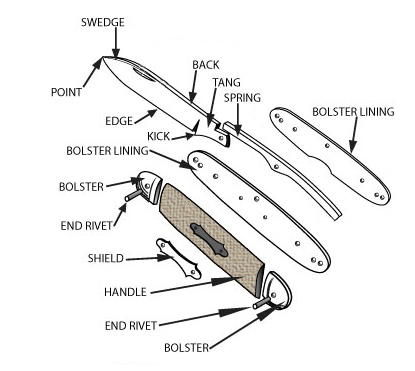
|
Maintenance
While many pocket knives are produced with metals that are resistant to corrosion or rust, pocket knives should still be regularly maintained.
Maintenance can be broken down into the following elements: Clean, Lube, Sharpen.
|
Clean
All pocket knives should be clean after each use.
Whether you're breaking down lumber to produce tinder for a fire or cutting up a fish for dinner the knife is exposed to elements that would cause the knife to corrode.
This is especially true if the knife is exposed salt water.
The best way to ward off corrosion is to clean the knife after each use.
All knives require proper care, folding knives especially require special care because of how the knife is designed.
Since there are moving parts on the knife (hinge and springs) the knife can be damaged if debris are introduced.
If possible, the knife should be taken apart, cleaned and reassemble.
If the knife cannot do so the user should clean the knife thoroughly with a cotton swab or rag.
After the knife has been cleaned the user may decide whether the knife should be lubricated or not.
|
Lube
Knives, especially folding knives, should be lubricated on a regular basis.
Lubrication is normally done through the use of mineral oil, all-purpose oil, or even WD-40.
Users should avoid cooking oil derived from vegetables or any oil that could breakdown.
By lubricating the knife regularly, it will ensure that the bearings are smooth and operating efficiently.
However, prior to lubricating, the user should see if the knife is clean and free from debris.
If the knife is not clean, the oil may actually introduce debris into the bearings.
Aside from lubricating the bearing and hinges of the knife, the blade of the knife can also be lubricated.
Since the main cause of corrosion is moisture, the blade of the knife may be lightly coated in oil which would prevent moisture from coming into contact with the blade.
The pocket knife does not have to be oiled after each use; however it is recommended that a pocket knife is lubricated two to three times a year.
|
Sharpen
Keeping a pocket knife sharp may be one of the most difficult elements when it comes to maintaining your knife.
To extend the life of the knife, manufactures have developed materials that are extremely hard which requires less sharpening.
However, the difficulty in sharpening the knife also increases when it does come time to sharpen the knife.
The process of sharpening a pocket knife requires that the rough surface on the edge of the blade to be remove and hone the edge so it is sharp and balanced.
This is normally done through the use by a hard sharpener which is made out of stone, metal, or even diamond abrasive.
Since we are removing the steel of the knife, the sharpening material must be harder than the knife itself.
The most common way for scouts to sharpen knives is through the use of a whetstone.
Whetstone comes in different grit level (how rough the stone is).
The lower the grit level, the coarser the stone and the more materials it could remove.
While the scout is sharpening their knife, the scout should use a stone at a low grit level and work their way up to a higher grit level, or from coarse to fine.
To start the sharpening process, the scout should lubricate the whetstone with water or oil and with with a coarse (approx 180 grit) whetstone to remove the old edge.
Once the edge has been removed, the scout should set the correct angle for the knife.
Depending on the knife, the angle may vary between ten to twenty degrees and should be created with a whetstone with approximately 320 grit.
The image below illustrates a whetstone.
|
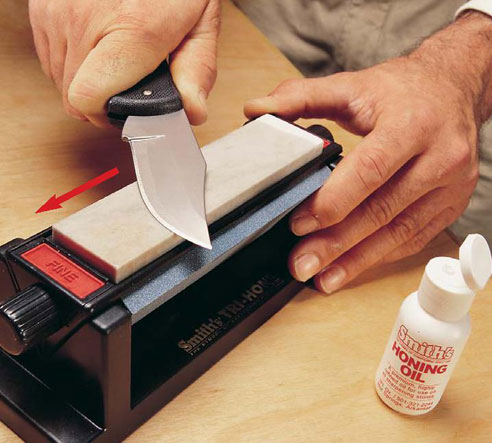
|
Once the angle has been set, the scout should continue sharpening the knife by applying moderate pressure and imagine that the knife is shaving the top of the stone.
Focus on one side of the blade before flipping the knife and starting on the other side.
More importantly, the scout should ensure that the angle of the knife is correct.
After one side of the blade has been sharpened, turn the knife over and start on the other side.
When both side of the blade has been sharpened using a medium grit stone, the knife can be honed with a fine grit stone.
By honing the edge of the blade, an extremely sharp blade can be created.
This is normally done with a stone that is 1000 grit, however, while sharp in the beginning, the sharpness of the knife will return to a knife that wasn't honed since the material on the knife after being honed is thinner than that of a knife that is not.
As noted above, sharpening a knife requires different materials and multiple steps.
Remember that safety is key.
A scout should sharpen a knife in a controlled environment, also known as a blood circle, where other scouts, people or objects are not in the way of the moving knife.
A scout should also remember that the knife should be cutting away from the body instead of towards the scout.
The list below are a few tips in maintaining your knife:
- Keep the entire knife dry
- Keep the knife clean, especially any moving parts that may be on the knife
- Keep the knife lubricated by regularly oiling the knife.
- Keep the knife sharp. A dull knife can sometimes be more dangerous than a dull knife
- Don't use the knife in ways it was not made for
|
Pocket Knife Safety
The Boy Scout pocket knife can be a lifesaving tool or a dangerous weapon.
As such each scout should use extreme care when using a pocket knife.
Prior to obtaining a pocket knife, each should should review and understand the rules noted on a Boy Scout Totin' Chip.
Other important pocket knife safety guidelines are listed below:
Keep your knife well maintained – A clean, sharp knife is actually safer to use than a dull one.
By having a clean sharp knife, a scout can target items that they want to cut instead of accidentally cutting something else.
A sharp knife also makes it easier when cutting or making tinder for fire building.
If you're still not convince, I’m pretty sure we all saw or heard about the movie “127 Hours.”
Lets just say it would have been better if the main character had a sharp knife.
Use a 'Blood Circle' – No, a blood circle is not something you make for a ceremony.
A blood circle (or safety circle) is an area within the radius of the arm and the knife combined.
By using a blood circle, the user of the pocket knife can form an area where other individuals may be at risk from getting hurt by the knife.
The image below illustrates a blood circle.
|
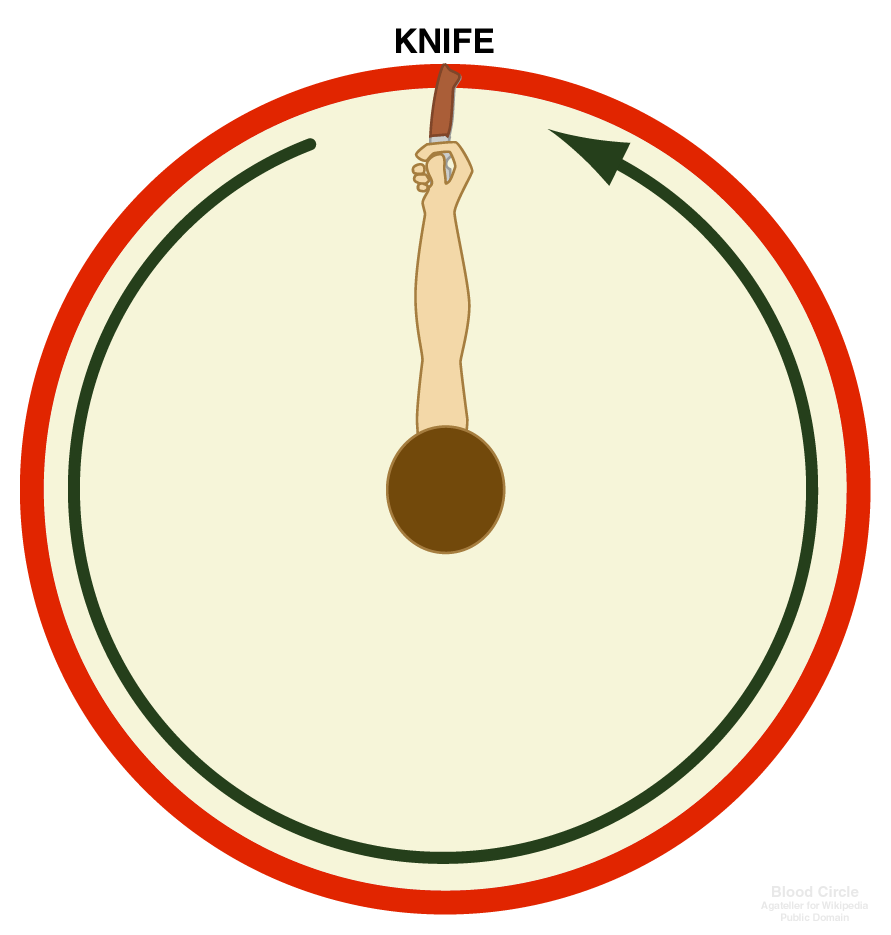
|
Say Thank You When Receiving the Knife – Aside from being polite saying thank you will tell the scout passing you the knife that you have a good grip on the knife.
There's nothing worst than getting your fingers cut up while on a weekend camping because the knife slipped out of your hand.
Pass the knife closed, if possible – The beauty of folding pocket knife is that they are able to close which eliminates getting cut by the knife when passing or looking for it in the pack.
If the knife is able to close, close the knife before passing it to another scout.
If the knife could not be closed, the scout handling the knife should hold the blade with the edge facing and passing the handle to the other scout.
By holding the blade of the knife, the scout handling the knife is in control and will reduce the risk of getting cut.
In the event that the knife does fall, do not try to catch it.
Just let it drop on the floor.
Again always say thank you!
Don't throw knives – It's always important to keep in mind that knives are not play things.
Knives are important tools that should be treated with respect and that includes not throwing them!
It may seem cool to see people throw knives on TV, movies, or even games but it is not cool if you accidentally hurt someone with it.
As responsible individuals you should remember to follow the safety rules when handling a knife.
Remember, knives are not toys, no matter how fun they may look.
Cut away from your body – Whenever a knife is in use it's common sense to keep clear from the direction that it is going.
So if you are the user of the knife the proper direction to cut things is to cut away from your body, not towards it.
Although the knife should always be cutting in the direction that takes it away from you it's also important to make sure that you aren't cutting towards others as well; remember the Blood Circle?
A knife is a knife – Yes, a knife can be a wonderful tool to have, but every user should keep in mind that a knife is just a knife.
It should not be used in ways that a knife is not meant to be used for.
There are other objects called “multi-tools” that can include a knife plus other handy tools (pliers, can openers, screwdrivers, etc) to get the job done right.
Respect the power of the knife safely and properly!
|
Totin' Chip
To show that a scout is certified and has the right to carry and use knives or wood tools, the Boy Scouts of America created the Totin' Chip.
Without this card on their person, a scout would not be allowed to carry or use these tools.
|
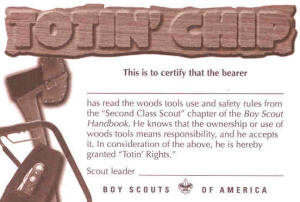
|
This card shows that the scout has read and understood the use and safety rules in the Boy Scout Handbook and follows the responsibilities that comes with the card.
To earn this certification, a scout must show the Scoutmaster or any other designated individual that the following requirements have been met:
- Read and understand woods tools use and safety rules from the Boy Scout Handbook.
- Demonstrate proper handling, care, and use of the pocketknife, axe, and saw.
- Use the knife, axe, and saw as tools, not playthings. Use them only when you are willing to give them your full attention.
- Respect all safety rules to protect others.
- Respect property. Cut living and dead trees only with permission and with good reason.
- Subscribe to the Outdoor Code and Leave No Trace.
The Totin' Chip card has four corners and these corners represent the number of infractions that a scout may have performed.
Any violation of these rules will result in a missing corner.
When all four corners are gone, the scout has lost his/her Totin' Chip rights.
|
|
|


















